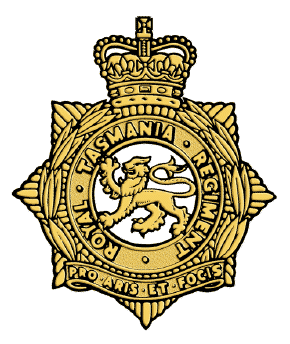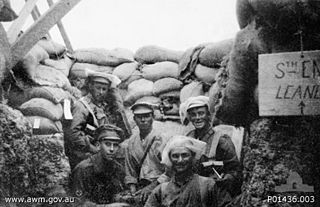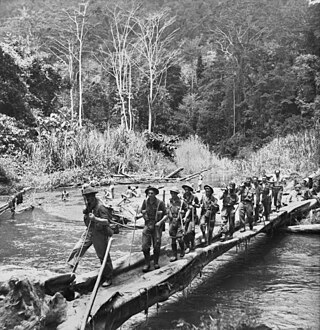
The Second Australian Imperial Force was the name given to the volunteer expeditionary force of the Australian Army in the Second World War. It was formed following the declaration of war on Nazi Germany, with an initial strength of one infantry division and related auxiliary components. After considerable expansion of this force, three divisions were sent to the Middle East and North Africa, while the 8th Division was sent to garrison British Malaya and Singapore.

The 7th Division was an infantry division of the Australian Army. It was formed in February 1940 to serve in World War II, as part of the Second Australian Imperial Force. The division was raised on the British establishment of nine infantry battalions per division and consisted of two new brigades and three of the original 12 battalions of the 6th Division forming the third brigade. The division is sometimes known by the nickname "The Silent Seventh", due to a perception that its achievements were unrecognised, in comparison to the other Australian divisions. The origin of this belief appears to be censorship of the part played by the 7th Division in the fierce fighting in the 1941 Syria-Lebanon campaign. The 7th Division along with the 6th and 9th Australian Divisions were the only divisions to serve in both the Middle East and the South West Pacific Area. It was disbanded in 1946, following the end of the war.

The 25th/49th Battalion, Royal Queensland Regiment is a Reserve light infantry battalion in the Australian Army, based in the state of Queensland. Although it was officially formed in 1997, the unit can trace its lineage back to units that were formed in 1875 as part of the colonial defence force of the state of Queensland. Additionally, in order to preserve the honours and traditions of the Australian Imperial Force, the battalion is the custodian of the battle honours awarded to two battalions that were formed for service during World War I. Following the end of the war, these units were raised again as militia units. During World War II, these battalions were called upon to participate in the fighting in the Pacific. Following the end of the war, these units were disbanded although they were later re-raised as part of the Citizen Military Forces, which was the forerunner to the Australian Army Reserve that exists today.

The 2/25th Battalion was an infantry battalion of the Australian Army which served during the Second World War. Raised in 1940, from volunteers drawn primarily from the state of Queensland, after completing its training the battalion undertook garrison duties in Darwin before deploying to the Middle East in mid-1941, as part of the 24th Brigade. There, it took part in more garrison duties in the Western Desert and in Palestine before it was reassigned from the 9th Division to the 7th Division and subsequently committed to the Syria–Lebanon campaign against the Vichy French. In early 1942, the 2/25th was returned to Australia to fight against the Japanese. Following this it took part in the fighting in New Guinea, undertaking two deployments there, firstly in 1942–1943 during which it took part the fighting along the Kokoda Track and around Buna–Gona, and then again in 1943–1944 when it helped to secure Lae before advancing into Finisterre Ranges. The battalion's final involvement in the war came in mid-1945, when it took part in the Borneo campaign, landing at Balikpapan. The battalion was disbanded in early 1946.

The Royal Tasmania Regiment (RTR) is a Reserve infantry regiment within the Australian Army consisting of a single battalion. Formed in 1960 following a review of military formations in Australia, the Regiment can trace its lineage back to the late 19th Century and has served Australia in a number of conflicts including the Boer War, World War I and World War II. Today it serves as a part of the Australian Army's 4th Brigade, 2nd Division.

The 2/4th Battalion was an infantry battalion of the Australian Army that was raised for service during World War II, as part of the Second Australian Imperial Force. Deploying to the Middle East in early 1940, the battalion took part in the early fighting in North Africa in early 1941 along with the rest of the 6th Division, before being sent to Greece and then Crete, where it was heavily engaged and suffered heavy losses. Rebuilt in Palestine, the battalion undertook occupation duties in Syria.

The 12th Battalion was an infantry battalion originally raised for the First Australian Imperial Force during the First World War. The battalion was recruited from Tasmania, South Australia and Western Australia and formed part of the 3rd Brigade, 1st Division. It served throughout the war, firstly during the Gallipoli Campaign and then on the Western Front. During the interwar years, the 12th Battalion was re-raised as a part-time military unit and during the Second World War undertook garrison duties in Australia, but did not see combat. Today its lineage is perpetuated by the 12th/40th Battalion, Royal Tasmania Regiment, a unit which continues to serve in the Australian Army Reserve.

The 2/10th Battalion was an infantry battalion of the Australian Army that was raised for overseas service as part of the all-volunteer Second Australian Imperial Force during World War II. Formed in October 1939, it was the first 2nd AIF unit raised from the state of South Australia during the war; after completing a period of training in Australia, the battalion embarked for overseas service. Initially, it had been intended that the 2/10th and its parent brigade – the 18th Brigade – would be sent to the Middle East to join the other brigades of the 6th Division, but instead the 18th Brigade was sent to strengthen the garrison in the United Kingdom after France capitulated in mid-1940. Re-assigned to the 9th Division, the 2/10th remained in the United Kingdom undertaking defensive duties until late 1940 when it finally arrived in the Middle East, where the 18th Brigade became part of the 7th Division.

The 18th Brigade was an infantry brigade of the Australian Army. The brigade briefly existed as a Militia formation prior to the First World War, but this was short-lived. During the Second World War, the brigade was raised on 13 October 1939 and was one of the first three infantry brigades of the Second Australian Imperial Force to be formed. Initially commanded by Brigadier Leslie Morshead, it served in the United Kingdom in 1940–1941, where it helped bolster the British garrison in anticipation of a possible German invasion following the Fall of France. In early 1941, the brigade was transferred to the Middle East where it later took part in fighting against the Italians in Libya and then helped to defend the besieged port of Tobruk before fighting against the Vichy French in the Syria–Lebanon campaign. The 18th Brigade was withdrawn to Australia in early 1942, and it later took part in the fighting against the Japanese in Pacific fighting several campaigns in New Guinea between late 1942 and early 1944. Its final involvement of the war came in mid-1945 when it took part in re-taking Balikpapan. Following the end of hostilities, the 18th Brigade was disbanded on 3 January 1946.

The 2/16th Battalion was an infantry battalion of the Australian Army, serving during World War II. Attached to the 21st Brigade that was assigned to the 7th Division, the 2/16th was raised in 1940 as part of the Second Australian Imperial Force from volunteers drawn mainly from the state of Western Australia. After training in Australia, the battalion was deployed to the Middle East where it undertook defensive duties along the Egyptian–Libyan border in early 1941 before taking part in the Syria–Lebanon campaign, fighting against Vichy French forces in June and July. At the conclusion of the campaign, the 2/16th remained in Lebanon, contributing to the Allied occupation force there, before returning to Australia in early 1942 following Japan's entry into the war. In August 1942, they were committed to the fighting along the Kokoda Track and then later fought around Buna and Gona. After a period of rest and reorganisation in Australia, the battalion fought around Lae and then took part in the Finisterre Range campaign in 1943–44. Its final campaign of the war came in Borneo in July 1945. At the end of the war, the 2/16th were disbanded in January 1946.

The 2/9th Battalion was an infantry battalion of the Australian Army during World War II. Raised in Queensland as part of the Second Australian Imperial Force shortly after the outbreak of the war, it formed part of the 18th Brigade and over the course of the war it was attached to the 6th, 9th and 7th Divisions due to several re-organisations. It served in the United Kingdom in 1940, forming part of a small Australian garrison sent there to help defend against a possible German invasion, before being transferred to North Africa where it took part in the Siege of Tobruk and then undertook garrison duties in Syria following the Syria–Lebanon campaign in 1941.

The 2/31st Battalion was an infantry battalion of the Australian Army that served during World War II. It was raised in June 1940 and was assigned to the 25th Brigade, 7th Division. It initially served in the United Kingdom where it undertook defensive duties before being moved to the Middle East in 1941. After taking part in the fighting in Syria and Lebanon, the battalion undertook garrison duties around Tripoli before being transferred back to Australia in 1942. In late 1942 the battalion was sent to New Guinea to fight against the Japanese along the Kokoda Track. They subsequently fought a number of battles throughout 1942, 1943 and early 1944. Their last campaign came in mid-1945 when they landed on Borneo. After the war the battalion was disbanded in March 1946.

The 25th Brigade was a brigade-sized infantry unit of the Australian Army that served during the Second World War. Raised in July 1940 and consisting of three infantry battalions, the 25th Brigade initially served in the United Kingdom, where it formed part of the garrison tasked with defending against a possible German invasion. In 1941, the brigade was redeployed to the Middle East where it took part in the Syria–Lebanon campaign fighting several actions around Merdjayoun and Jezzine.

The Battle of Goodenough Island, also known as Operation Drake, was a battle of the Pacific campaign of World War II. The Allies landed on Goodenough Island, Papua, and clashed with a Japanese Kaigun Rikusentai. The Japanese troops had been stranded on the island during the Battle of Milne Bay in late August 1942. "Drake Force", consisting of the Australian 2/12th Battalion and attachments, landed on the southern tip of Goodenough Island at Mud Bay and Taleba Bay on 22 October, tasked with denying the Japanese use of the island prior to the Buna campaign. Following a short but intense fight, the Japanese forces withdrew to Fergusson Island on 27 October. After the battle, Goodenough Island was developed into a major Allied base for operations later in the war.

The 21st Brigade was a brigade-sized infantry unit of the Australian Army. It was briefly raised in 1912 as a Militia formation providing training as part of the compulsory training scheme. Later, it was re-formed in April 1940 as part of the Second Australian Imperial Force, the unit was raised for service during World War II. As part of the 7th Division the brigade's constituent units were raised from volunteers from several Australian states. After rudimentary training in Australia, the brigade deployed for the Middle East in October 1940. Defensive duties were mounted along the Libyan border in early 1941, before the brigade was committed to the Syria-Lebanon campaign, fighting against Vichy French forces. In early 1942, following Japan's entry into the war, the brigade returned to Australia. After a period of defensive duties in Australia, it was deployed to New Guinea and subsequently played a key role in the Kokoda Track campaign, delaying the Japanese advance towards Port Moresby and then joining the pursuit as the Japanese withdrew towards Buna–Gona. In 1943–1944, the brigade took part in the capture of Lae and the Ramu Valley–Finisterre Range campaign. Its final campaign of the war, came in the final months when it took part in the Balikpapan landings. It was disbanded in 1946.

The 58th/59th Battalion was an infantry battalion of the Australian Army which served during the Second World War. Raised in 1942 as part of the Militia through the amalgamation of the 58th and 59th Battalions, it formed part of the 15th Brigade, assigned to the 3rd Division. Initially the battalion undertook defensive duties in Australia before being deployed to New Guinea where it took part in the fighting around Salamaua and Lae and then the Finisterre Range campaign. In 1945 they were sent to Bougainville where they took part in the fighting in the southern sector of the island. Following the end of the war, the battalion was disbanded in 1946.

The 2/33rd Battalion was an infantry battalion of the Australian Army during the Second World War. It was formed as part of the Second Australian Imperial Force in the United Kingdom in June 1940 as the "72nd Battalion" to create the 25th Brigade, which eventually became part of the 7th Division. After the threat of invasion had passed, the battalion was transferred to the Middle East in early 1941, and after a period of garrison duty in the Western Desert, the battalion fought against the Vichy French in the invasion of Syria and Lebanon.

The 2/27th Battalion was an infantry battalion of the Australian Army during World War II. Raised in May 1940 as part of the 7th Division from volunteers from the state of South Australia, the battalion was assigned to the 21st Brigade. After completing training in Australia, the 2/27th deployed to the Middle East in November 1940, and in early 1941 undertook defensive duties in the Western Desert. The battalion's first combat experience came against the Vichy French during the short Syria–Lebanon campaign during which it fought major engagements around Sidon and Damour. At the conclusion of the fighting in Syria, the battalion remained in the area as part of the Allied occupation force until early 1942 when it was returned to Australia to fight against the Japanese.

The 2/24th Battalion was an infantry battalion of the Australian Army, which served during World War II. A unit of the all-volunteer Second Australian Imperial Force, it was formed in July 1940 from primarily Victorian volunteers and was known as "Wangaratta's Own" because of the time the battalion spent in the town during its formative period prior to deployment overseas. It served in North Africa in 1941–1942 as part of the 26th Brigade, which was assigned to the 7th Division, before being reassigned to the 9th Division. In early 1943, the battalion returned to Australia and later took part in campaigns against the Japanese in New Guinea in 1943–1944 and Borneo in 1945, before being disbanded in 1946. The 2/24th suffered the highest number of battle casualties of any 2nd AIF infantry battalion.

The 2/8th Field Regiment was an Australian Army field artillery regiment that was raised for service during the Second World War as part of the all-volunteer Second Australian Imperial Force. Composed mainly of soldiers from the states of Victoria and Tasmania, the regiment was one of three field artillery regiments that were assigned to the Australian 9th Division during the war, and during its war service it saw action in North Africa in 1941–42, being heavily involved in the First and Second Battles of El Alamein between July and November 1942 before returning to Australian in 1943, as the Australian government rebalanced its land forces to face the threat in the Pacific. Nevertheless, the regiment did not see action again until mid-1945 when it was committed to the brief Borneo campaign. It was disbanded in early 1946 at the conclusion of hostilities.





















